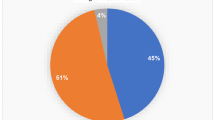Abstract
Otolaryngological conditions constitute a major share of emergency medical problem among children. The present study was conducted to assess the patient profiles, incidences morbidities, mode of presentation and managements of different otolaryngological emergencies among pediatric patients presented in a tertiary care hospital. Descriptive cross-sectional study by analysing retrospectively collected information pertaining to the patients attended ENT emergency service department of a tertiary care hospital, Kolkata. Data were collected using predesigned proforma and were analysed with the help of SPSS version 20. About 39.0% of total ENT emergency attendance was contributed by pediatric age group. The male female ratio was 1:1.33 with average age of 58.95 ± 34.42 (mean ± SD) months. Half of the attendees had ear problem and almost one-third reported complaints related to nose. The major complaints at the time of presentation were earache (32.3%), nasal foreign body (24.0%) and aural foreign body (13.3%) closely followed by aero-digestive tract foreign body (12.0%). Inflammatory conditions affected the ears more, foreign bodies found most commonly in nose and miscellaneous condition such as impacted wax was found to be related to ear in significantly higher proportion. Conservative management was provided to 96.25% of patients. Foreign body insertion was found to be associated with lower age group. Most of the emergencies were managed conservatively which might be done at subdivision or district level to reduce the undesirable burden on the tertiary care medical colleges.

Similar content being viewed by others
References
Census Data of India (2011). http://www.censusindia.gov.in. Accessed 14 Feb 2017
Al- Mazrou KA, Makki FM, Allam OS, Al-Fayez AI (2009) Surgical emergencies in pediatric otolaryngology. Saudi Med J 30:932–936
Kumar S, Gulati A (1999) Pediatric emergencies in otolaryngology in a metropolitan city. Indian Pediatr 36:1256–1258
Signorelli LG, de Abreu Mendes E (2013) Prevalence of otorhinolaryngologic diagnoses in the pediatric emergency room. Int Arch Otorhinolaryngol 17(1):10–13. https://doi.org/10.7162/S1809-97772013000100002
Saha S, Chandra S, Mondal PK, Das S, Mishra S, Rashid MA, Mondal AR (2005) Emergency otolaryngological cases in medical college Kolkata—a statistical analysis. Indian J Otolaryngol Head Neck Surg 57:219–225. https://doi.org/10.1007/BF03008018
Mukherjee A, Haldar D, Dutta S, Dutta M, Saha J, Sinha R (2011) Ear, nose and throat foreign bodies in children: a search for socio-demographic correlates. Int J Pediatr Otorhinolaryngol 75:510–512. https://doi.org/10.1016/j.ijporl.2011.01.006
Author information
Authors and Affiliations
Corresponding author
Ethics declarations
Conflict of interest
There is no conflict of interest among the authors.
Rights and permissions
About this article
Cite this article
Dutta, S., Haldar, D., Aggarwal, N. et al. Pediatric Otolaryngological Emergency: An Experience from a Tertiary Care Teaching Institution at Kolkata, India. Indian J Otolaryngol Head Neck Surg 70, 490–494 (2018). https://doi.org/10.1007/s12070-018-1490-5
Received:
Accepted:
Published:
Issue Date:
DOI: https://doi.org/10.1007/s12070-018-1490-5




